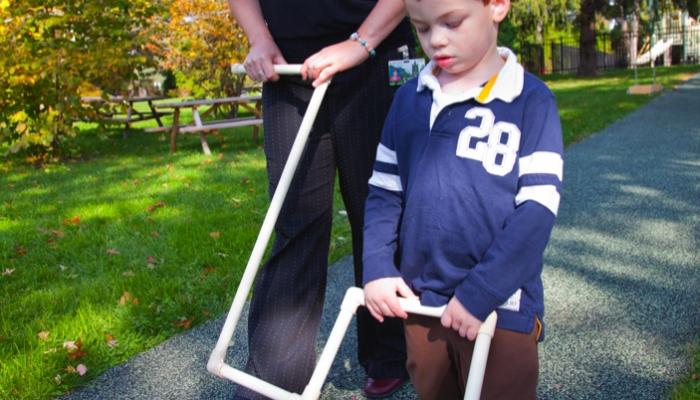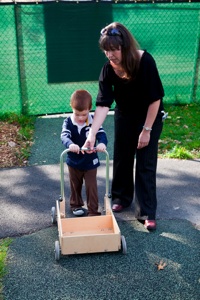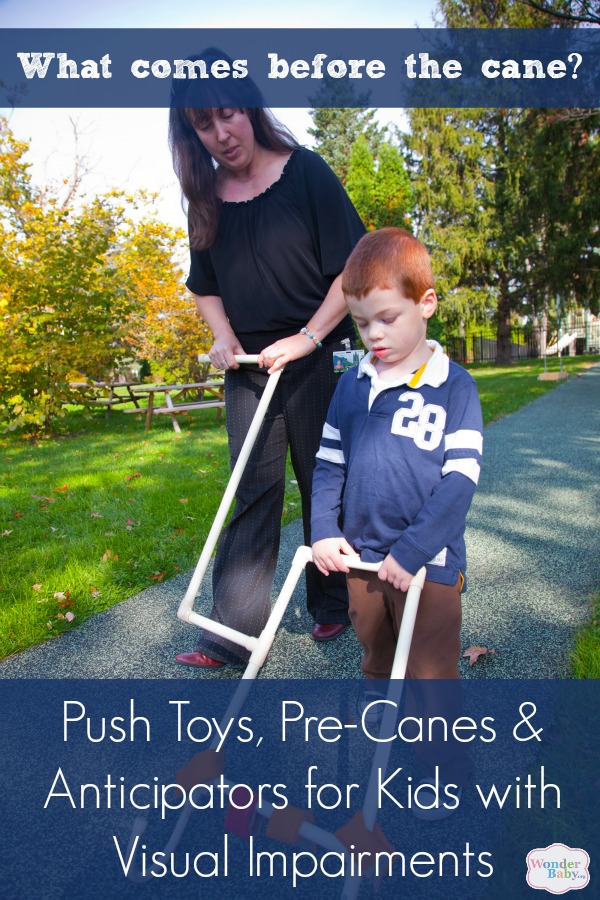Anticipators for Young Children with Visual Impairments: Push Toys, Pre-Canes and Long Canes

This post may contain affiliate links; please see our terms of use for details.
By Laurel J. Hudson, Ph. D. and Paula R. Kosior, M.Ed., C.A.E.S
“Anticipators” are toys or pieces of equipment that children with visual impairments push in front of them as they walk. The most common anticipators are push toys, precanes and long canes.
These devices give children advanced information about their environments. For example, when a young girl is pushing a toy stroller and feels it stop, then she can anticipate that a wall or object is in front of her.
While all caregivers work together to promote safety in young children with visual impairments, it is the Orientation and Mobility Specialist who should lead the process of selecting the appropriate mobility device and teaching its use. Specific criteria strategies follow.
Benefits of Anticipators
Push toys, pre-mobility devices and long canes contribute to children’s orientation and mobility in a variety of ways. This may be the only way some children feel comfortable navigating independently. Some early walkers need a bit of support for balance to move freely within their environment and using a device, instead of an adult’s hand, will allow them to walk more independently.
Devices also generally improve children’s gait. Moreover, in terms of safety, their use helps children find a clear path and to locate objects along the way. Pushing something out in front of the body is the only independent way to find steps or obstacles below the level of the hips (other than feeling along with a toe).
Devices help children to learn the dimensions of a space without hand trailing and most importantly, their use introduces children with visual impairments to life-long orientation and mobility skills.
When Should a Child Begin Using an Anticipator?
It is the Orientation and Mobility Specialist’s decision to determine readiness for these devices, given input from a child’s family (for children with significant balance, tone, and/or endurance issues a physical therapist should also be involved with this decision).
In deciding whether it is time to introduce a device, Orientation & Mobility Specialists should consider whether children are walking, whether they are motivated and interested in moving and whether they understand “tools” in general as an extension of their bodies.
Everyone working with a child should also consider whether there is a functional need for an anticipator in his or her daily routine, and who will take responsibility for it when the child isn’t pushing it.
Choosing a Device
Which device is best for a specific child? Decide this on the basis of the following three criteria:
- Some devices are supported by the child; if children let go of them, the devices drop to the floor or ground. Others are self-supporting; if children let go of them, they stay in place, and do not drop to the floor or ground.
- Children push some devices with one hand, and other devices with two hands.
- Some devices are considered toys (like push toys) and others are considered more “formal” mobility devices (like pre-canes).
These criteria combine in different ways. For example a child’s shopping cart is a self-supporting toy, pushed with two hands; in contrast, a long cane is child-supported, pushed with one hand and formal.
Push Toys: Some specific examples of self-supporting toys which children push with two hands are miniature grocery carts, lawn mowers, vacuum cleaners, doll carriages and walkers that have other features (knobs to turn, lights, horns, shape sorters etc.) An example of a child-supported two-handed toy is a hula-hoop. Some child-supported one-handed toys are popcorn popper push toys, hockey sticks and miniature brooms.
- Formal Devices: The most common “formal” devices supported by the child using two hands are the Connecticut pre-cane and T and I shaped pre-mobility devices. These are typically constructed out of PVC or other plastic piping materials. Orientation and Mobility Specialists custom design other devices for individual children. Self-supported formal devices which children push with two-hands are also used occasionally. Most move only forward and backward; some have swivel wheels, which allow smooth movement in all directions. Features may include brakes, carrying baskets and the ability to change height as the child grows. Lastly, the major example of a “formal” device supported by the child with one hand are standard or adapted long canes.
Self-Supported Devices: Advantages & Disadvantages
There are some important advantages in devices being self-supported. If your child moves away from it, it will remain in the same position. Children don’t need to locate them, pick them up, and reorient them. They only need to push them. Usually, self-supporting devices have wheels that allow them to move smoothly forward and backward, although turning may be cumbersome. Self-supported devices may assist children who need to feel a little more balance or stability when walking.
However, self-supported devices have some clear disadvantages. They may tip over easily, although additional weights, like heavy toys in a shopping cart, may make them sturdier. The wheel bases on these devices may be too narrow (thus promoting a wide base of support as children try to straddle the wheels), or the children’s feet may knock directly into the back of them (resulting in children walking with a short and choppy stride length). Lastly, these devices may be bulky and heavy to store and carry.
One Versus Two Hands: Advantages & Disadvantages
In most cases, it is easier for children to push devices with two hands rather than one hand. In two-handed grasps, hands are usually centered and in front of their bodies (symmetrical body positions appear earlier developmentally than asymmetrical).
However, children who find touch aversive may prefer to use just one hand. Ultimately, children should learn to push with just one hand because this leaves a hand free to follow surfaces, to carry things and to develop readiness for more mature cane techniques.
Push Toys Vs Formal Devices: Advantages & Disadvantages
Push toys are age-appropriate, fun, brightly colored and reasonably priced. They tend to be used by all children. Using a more formal device usually indicates a change to more “serious business” and instruction, rather than play with a toy.
Children who have usable vision may not be able to “see” the ground or terrain while using a push toy, although using an empty grocery cart usually provides more visibility than using a doll carriage. Mobility devices also vary in height, materials, weight and intended use (indoors or outdoors).
In general, children most often begin by pushing self-supporting two-handed push toys and proceed to devices which are one-handed, child-supported and more formal.
General Guidelines
All devices should be sturdy and made of materials that are durable and strong. Children’s feet should not contact them during normal stride length. Devices should be at a comfortable height for children to push—this is usually waist height or a big higher. Most important, children should feel comfortable with their anticipators and have fun pushing them.
In self-supported devices, bases of support should be wide enough so children can walk behind them comfortably and with a normal gait. Because children may use self-supported devices to slightly steady their balance, they should not be too light (easy to tip over) or too heavy (difficult to push).
Special consideration goes into choosing long canes for children with visual impairments. One of the most important questions is, “Does the child have enough readiness skills to begin using a long cane?” In addressing this question, Orientation and Mobility Specialists should bear in mind that long canes require children to have excellent body awareness in order to keep them oriented in front of their bodies.
Orientation and Mobility Specialists generally order child-sized long canes from standard cane manufacturers. Like adult-sized long canes, these come with different tips, grips, styles, colors and heights, depending on the specific needs and travel expectations of the child. Grips should be small enough for children’s fingers to wrap around them. Ball tips can be fun, and they can alert children with low vision to their placement. Because they tend to stick less, children can use ball tips more comfortably with less refined technique. Although rigid canes may give clearer information, folding/telescoping styles may be more realistic for families to carry.
Anticipator Skills
Using anticipators effectively requires competency in three major areas: toleration and position of devices while children are walking; use of devices throughout their daily routines; and use of devices to gather information about their environments.
First, children learn to tolerate their devices and use them throughout their daily routines. With practice, they treat them in a responsible manner, without throwing them, banging them, lifting them in the air, swinging them or batting at walls or objects with them.
In developing technique, children hold their devices with correct grip and hand positioning. They keep them oriented and in front of their bodies, holding most at a 45-degree angle. Children learn to maneuver their devices around objects and to follow a line and/or shoreline. Young children begin to learn the same long cane skills as adults: labeling parts, cane orientation and storage, keeping the cane in contact with the surface, diagonal cane technique, keeping the cane centered, carrying the cane when walking sighted guide, etc.
With acquisition of functional motor skills, children can use their devices to gather information about their environments. They learn to walk with them on all types of surfaces and terrains, detecting changes in elevation and different surfaces with the device, and stopping when they contact objects. Eventually learning to use audition, taction, vision and echolocation skills at the same time as using their devices, they learn to explore with their hands the objects they encounter. Ideally they learn to keep track of where they are at the same time as using their devices.
Teaching Anticipator Skills
 Orientation and mobility lessons with young children are short; preschoolers typically receive 20 minutes of direct instruction and 10 minutes of consultation per week in the United States. Within this session, it is not unusual to get as few as 3 to 5 minutes of “productive” lesson time with some youngsters. At these early ages, specialists typically overlap and their services are less delineated.
Orientation and mobility lessons with young children are short; preschoolers typically receive 20 minutes of direct instruction and 10 minutes of consultation per week in the United States. Within this session, it is not unusual to get as few as 3 to 5 minutes of “productive” lesson time with some youngsters. At these early ages, specialists typically overlap and their services are less delineated.
There are some unique mobility instructor positioning variables in working with children. Young children may not have the upper body strength to push devices across difficult surfaces or for long distances. Instructors may actually help to push them. In addition, they may internally select those portions of routes which give children the most proof of protection, at first encouraging device use mostly at these times. Initially, instructors may alternate device use with sighted guide techniques as often as every five to ten steps. While children negotiate stairs, instructors carry their devices, while, at the same time, monitoring their safety.
Orientation and Mobility Specialists tend to stay physically closer in teaching young children than they do with older students. Since these lessons may represent the first time children have walked with anyone other than their family members, they may need close proximity to develop trust. In addition, instructors need to stay within arm’s reach for children who may “dart.” Obviously, they should stay close to young children near all traffic, as they would with any child.
Children must understand that their anticipators are tools that they can use when they are walking in free or open space, while holding an adult’s hand, and while cruising or trailing along a surface. Depending on their ages, they learn to know and understand safety words like “stop” and action/directional words and phrases like “push,” “you dropped it,” “pick it up off of the ground” and “in front.” Most importantly, children need to conceptualize the relationship between their devices and the environment (for example, when his push toy dips, a little boy needs to expect a step down; first it’s the push toy’s turn and then it’s his turn).
To motivate young children with visual impairments to do this, tap into what they consider fun and important. Very young children might especially enjoy a game of “Walk to Mom”: walk a few steps with a doll carriage, get a hug, be helped to “turn around,” then “Walk to Dad” a few steps, gradually increasing distances. Use flashlights, visually attractive toys and sounding toys which children enjoy and may walk towards, away from, or alongside. Help children practice walking toward familiar landmarks, encouraging them to notice what information their anticipators are giving them about the upcoming environment. Lastly, use music and games to motivate device use, varying tempos to modulate pace. Bear in mind, however, that music may mask other environmental sounds and that listening to music may interfere with concentrating on safety and orientation space.

Related Posts

Eye Conditions and Syndromes, Visual Impairment
Neuralink Announces Plans to Restore Sight to the Blind with Brain Chip
Elon Musk’s company Neuralink has announced plans to begin human trials of its new “Blindsight” brain chip by the end of 2025.

Visual Impairment
The Gift of Understanding: How a Young Child Helps His Blind Father Navigate Life
When a parent is blind, it’s natural for people to wonder how their sighted child will adapt. Will they struggle to understand their parent’s needs? Will they feel burdened by...

Braille and Literacy, Toys, Visual Impairment
24 Braille Toys for Kids Who are Blind
Everything from alphabet blocks to raised line coloring pages and activity books to puzzles to card and board games... and so much more! And it's all in braille ready for...

